May 13th-26th 2012
A busy fortnight, although I am not sure I like the word busy. Busy people are sometimes trying to avoid rather than confront problems in their lives in my experience."Usefully occupied" is a term I prefer! The weather improved abruptly during the period, switching from midwinter chilliness (15`C) on 21st to midsummer heat (27`C) on 23rd in little more than thirty-six hours.
Helped Mike Sanderson run a birdwatching course for the Othona Christian Community at Bradwell between 15th-17th - an enthusiastic and sociable bunch of people - and on the final day we visited Danbury Common to listen for Nightingales. We heard six in the end, most thumping away within a few feet of us without ever showing themselves, or giving only the fleetest of glimpses. It is a beautiful area, well managed by the National Trust, and there were also lots of Whitethroats, Chiffchaffs and Blackcaps in song along with a solitary Garden Warbler and at least three Cuckoos. Lunch was taken sitting in the sunshine on Toot Hill, Hitchcock Meadows EWT Reserve, where we were surrounded by Green-winged Orchids, Milkwort, Tormentil and a few late Heath Violets plus many more abundant species such as Common and Sheep's Sorrel, Bulbous Buttercup and Sticky Mouse-ear. There was a solitary Meadow Saxifrage in bloom inside one of the rabbit-proof enclosures while Lesser Calamint - not yet in flower - appeared to be thriving in another. Counted 655 spikes of Green-winged Orchid, a good showing after two dry springs when there were very few. A very pleasant time was had by all.
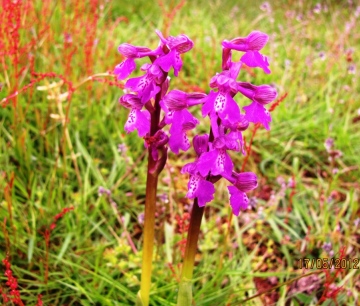
The BTO are organising a Nightingale Survey this year, a follow up to the last one in 1999, the aim being to plot changes in status and distribution since then. Results so far in Essex suggest that the population is now concentrated between Danbury and Colchester, with very few in the south and none at all in the NW, including Hatfield Forest. Counts in so far include 17 singing ♂♂ at Danbury Common and an impressive 42 at Fingringhoe Wick EWT Reserve, probably one of the highest concentrations in the country.
The re-appearance of the sun after eight long weeks of cold and wet was balm for both body and soul. Not that I am one for sunbathing - I have always likened it to practicing for being dead - but it was good to discard the heavy coats and boots of winter and to feel that you were no longer encased in a suit of armour! Wildlife responded almost immediately to the sudden rise in temperature. There have even been a few moths in the garden trap during the past week instead of an occasional wasp, drowsy bumblebee and spider! Among them were a Puss Moth (only the second I have caught in the garden) and an Iron Prominent.
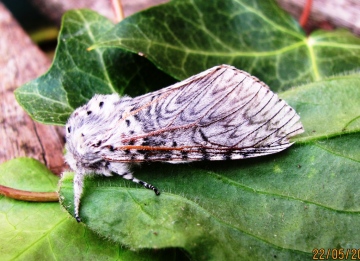 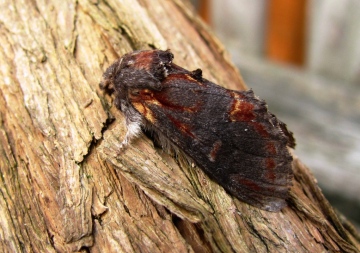
As in the case of Woolly Bears we used, as kids, to collect Puss Moth caterpillars and rear them at school. They were spectacular beasts, bright green with a brown 'saddle', and had an almost parrot-like face. They would rear up when disturbed and wave their two modified, whip-like back legs at you, and we of course were convinced they could sting us, handling them with great care! Alas, they are much less common nowadays. Another insect that fascinated us as children was the May Bug or Cockchafer, probably because their directional system when flying is of a very basic nature and they had a habit of crash landing on you on warm summer evenings.
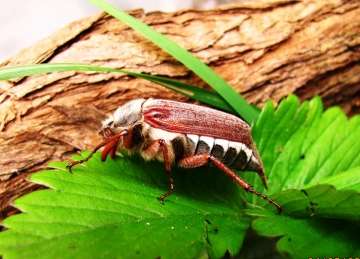
After the spring we have experienced bliss can be defined as relaxing in the garden with a glass of wine and a good book to read. Holly Blues, Peacocks, Small Tortiseshells and Orange Tips have all put in an appearance during the past few days, bees are buzzing once more, and as dusk falls I am regularly entertained by a couple of Pipistrelles weaving erratically between sheds and shrubs, suddenly changing tack to pluck up an unsuspecting small tipulid fly or other insect from just above my head. Summer at last! Victor Mildrew and Wrabness Rambles
Thanks Michael and Graham, I thought I was being a 'Victor Mildrew' over name changes. It's not just me after all. Common Bullfinch indeed, saw one Sunday at Wrabness, the first in a year. How "common" is that? Incidently where do we have to go to find the Uncommon Bullfinch. Taking advantage of the sunny weather we have made a couple of visits to the Wrabness Nature Reserve over the past week. Butterflies were not very plentiful, Small Heath, Clouded Yellow, Small Copper and an unidentified 'White' all singletons were recorded. we did manage to find a pair of Cinnabar Moths though. We were rewarded with views of a Slow Worm and three Common Lizards 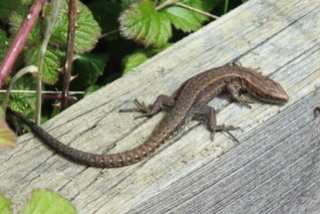 Three invertebrates were spotted that took our attention the first being the caterpillar of the moth Scarce Footman (Eilema complana) which were found at several locations on the reserve on the sawn timber of fences etc. 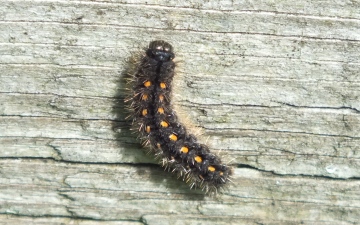 Next was a weevil (Lioploeus tassulatus) 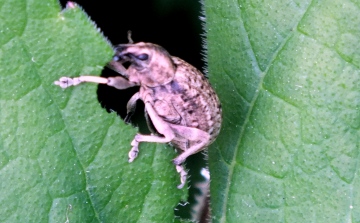 This insect was found feeding on 'Cow Mumble', and was by far the biggest weevil I have seen, estimated at 10+mm in length. It appeared quite active and nervy, so I took a long shot of it before trying to get in close. As a hand was extended towards it, it lept off its food plant and was lost in the dense grassy undergrowth. So the long shot proved a good idea, but didn't produce a good photo. Thirdly, in the long grass on the edge of the river a Cardinal Beetle (Pyrchorea serraticornis) was noted and the following photo taken 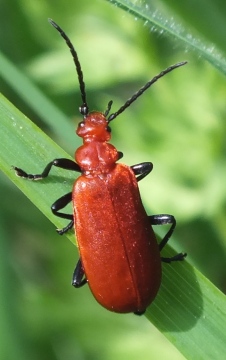 Ladybirds listed were 7-Spots which were to be seen all over the reserve. A few 14-Spots and one 24-Spot There were very few bees about despite the warmth and abundant Hawthorn blossom and numerous wild flowers. The most numerous being the Common Carder, even then there were only small numbers. As for birds, while summer visitors, Whitethroats, Nightingale, Chiffchaff, Willow Warbler, and Cuckoo entertained us with songs of summer, winter stragglers, Brent Geese, still fed along the saltings. Name Changes
Eurasian Robin? Northern Wheatear? Hedge Accentor? As opposed to the likes of American Robin, Black-eared Wheatear and Alpine Accentor. We have only one Robin, one Wheatear and one Accentor breeding in this country and had never felt the need to elaborate until recently when the BOU decided that we needed a more definitive approach to our use of vernacular names. It is not likely to help foreigners interpret articles in English as different countries have different vernacular names for these species and, anyway, the Latin name - which should always be included in articles of a scientific nature - should make it clear exactly what species is being written about. Order and consistency are what they had in mind presumably but whether such changes were necessary............. As for the newly created Common Cuckoo, Common Kingfisher, Common Bullfinch and Common Linnet - there is a depressing series of misnomers for you! With regards to the Winter Wren, bird taxonomists tend to be either 'lumpers' or 'splitters' but I'm not sure whether current thinking is to 'lump' the American bird with our own or to 'split' it into a separate species. Come back next week and the answer may be different! The 'splitters' seem to have won with the Chiffchaff (sorry, Common Chiffchaff) but I'm not sure exactly how many species there are considered to be at present - it could be up to a dozen!
Personally, I like to keep the old English names going - those that were taught to be during childhood walks with my father and grandfather. Thus, a Robin will always be a Redbreast, a Hedge Accentor a Hedge-e-Bet, a Great Tit a Tom Tit, a Mistle Thrush a Mavis, a Wren a Jenny and a House Sparrow a Spadger or a Sprog. Then there is Plum Pudding for Red Campion, Shirt Buttons for Greater Stitchwort and Paeggles for Cowslip, not to forget the dear old Hodmedod, otherwise known as the Garden Snail!
Modern natural history does sometimes seem obsessed with lists. World Lists, National lists, County lists, Vice County Lists, Reserve Lists, Red Data Book Species lists, Biodiversity Action Plan Lists and so on and so forth, ad nauseum. They are often necessary of course, especially when writing articles on a given area, but there are times when I feel that their chief purpose is to simply advertise the achievement of the person doing the listing. Modern birdwatchers - or Birders as we are now known - are particularly addicted to this form of listing. There is much more to natural history than that and last Friday I was fortunate enough to attend a lecture given by the author Richard Mabey, who emphasizes that in his work. It was held in the Dame Bradbury's School at Saffron Walden and took the form of an interview rather than a lecture. It only lasted an hour, with a further twenty minutes for audience questions, and there were no slides, only anecdotes from the author, but it was a truly marvellous experience. There is a man who appreciates that relaxing beneath the shade of a tree on a warm summer's day, idly watching Swallows skim low across the wheat fields while the mind settles drowsily, deliciously, into peace to the soft crooning accompaniment of Turtle Doves in the wood behind and a duet of church bells and Cuckoos drifting across the meadows from afar is just as much about natural history as listing everything that moves!
Incidentally, I have always looked on Saffron Walden as an upmarket kind of place but I see that it has the same problems as the rest of us. The large green open space near where we parked was littered with groups of youngsters enjoying a beautiful summer's evening when we arrived and littered with their rubbish when we left!!! Name changes, do we need them?
Noted Peter Ps, remarks regarding those name changes. My reaction to these frequently occurring
and usually unnecessary alterations is that some authority, usually of the professional variety, has
to make his or her presence felt by meddling. Names that have happily sufficed for centuries, are
changed and maybe someone somewhere feels good and important that they have left their personal
mark on nomenclature. Away with the revisionists I say.
After all change here in North East Essex, like elsewhere of course, suddenly it is Spring.
My vegetable seedlings, erstwhile stunted, have spurted into growth and there is great activity
all around this place, especially in the bird world. All dashing about some with offspring in tow
others rushing into partnerships. We were especially pleased to observe Blue Tits back and
forth to a nest box sited near to our back door, but even better, this can be kept under close
surveillance from a comfortable armchair in our lounge. And that has proved very interesting
allowing us to watch the interaction between the parents as they bring in, glad to say, an
apparent abundance of invertebrate food. The fare to sustain perhaps eight or more offspring
seems of a wide variety. I am sure this included worms, and various grubs and caterpillars and
one brought in a butterfly. There seems to exist a measure of entry discipline being observed
by the adults - sometimes when one bird is already in the box the other returning partner
appears to either wait on the external perch or due to some form of communication will fly off to
a nearby bush until his mate exits and then immediately home in to deliver his or her contribution.
On a couple of occasions have noticed a bird perched waiting to enter the nest will flutter its
wings and assume this too may be some form of communication.
Whatever, it has given us great pleasure after such a poor start to this important season, that
nature is taking every advantage of these equable conditions. For most of this week shade
temperatures have been wonderfully normal, as once more the climate appears in, what, just
over a five days to have stood on its head!
I look at and admire others forum pictures. I too try to take photos of natural history objects
and scenes and maybe I could include the occasional image if some comment needs an
illustration. I looked at the advice over inserting such, but tried to send a picture when I talked
about astronomy, but somehow did not achieve. Maybe I need a bit of help here and so can
some kind person advise. You can email me using michael.daniels1@tesco.net - thanks in
anticipation.
Peter,
Thanks for the offer of a possible full identification of the bees I submitted by way of photographs. Unfortunately they were in a very public area. On the 13.5.2012 when I took the photo's we had to remove a stone which had been forced into the entrance to the nest. After reading your reply to my I.D. request I visited the site again to find no sign of life and no fresh excavation spoil. I assume they have deserted the site through disturbance. By the way the name I posted was found on the web where I did the research into the two bees. There seems to be so many changes lately, not only to scientific names, but to common names too. Why is our good old friend the Robin now known in some quarters as the "Eurasian Robin", the Lapwing as "Northern Lapwing". I have recently pointed out to i-Spot that the Winter Wren which they insist is our Wren, is a seprate North American species. Enough rambling, thanks for the offer, but no specimens are left now.
Dear Peter
I think you are probably correct in your two identifications (the Andrena is usually still known in this country by its older name of A. scotica), but the definitive identification of most solitary bees requires microscopical examination of characters, and these two species are no exception - it is necessary to see features not visible in your photos to confirm their identity. You are welcome to send an example of each to me at Peter Harvey, 32 Lodge Lane, Grays, Essex RM16 2YP. Bee identity
On Sunday last, my grandson showed me a bees nest he had found in the metal liner of an underpass at Highwoods Colchester. It had been excavated through a bolt hole in the metal casing of the structure. 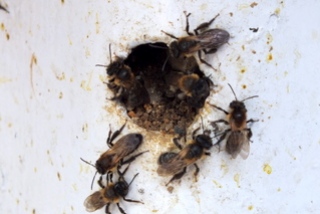 He thought he had found a wild honey bees nest and wanted an identification. To all intents the bees did resemble honey bees but were a little smaller. 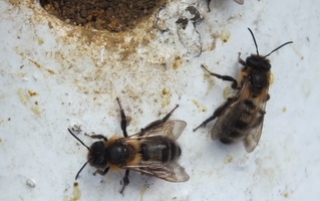 The nest was obviously occupied by a number of insects and there was a constant stream of bees with laden with pollen entering the nest. I believe they were Adrena caratonica which researches suggest gather to nest in this way, in a group but with individual cells. Added to this a small bee was seen to enter the nest which I believe was Nomada marshamella a parasite of A.caratonica, pictured below. 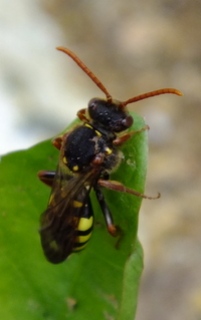 Confirmation of the identy of these bees would be appreciated if possible please. April 29th-May 12th 2012
Spring is still skulking behind a screen of cold and wet, showers or longer outbreaks of rain occurring on nine of the thirteen days while temperatures at night seldom struggled above 4`C. Nothing unusual in that - the past fifty years of memory are littered with such seasons - but you feel the loss keenly as you grow older and have fewer left to enjoy!!! Many of our summer migrants are finding it hard to get back home and lots have doubtless died while struggling northwards against bad weather and hostile winds both here and in southern Europe. As Peter discovered, Chris, one of the five Cuckoos radio tagged in Norfolk last spring by the BTO, has finally made it back to the UK, making landfall near Epping before moving on to Thetford Forest, where he was ringed. Another, Lyster, has also got home but two have died en route, after wintering successfully in the Congo, and a third, Kasper, is still missing. Another safe arrival was a rufous-phase female at Blue House (all birds this colour in spring are females - probably a genetic variation), almost certainly the same bird that was present here last spring. Had to wait until May 4th to hear my first Cuckoos though - a male and two females at Heybridge Gravel Pit - this probably being the first time I have failed to hear one in April in the sixty years since I heard my first as a five year old! They appear to be absent from the Ingatestone/Highwood area for the second year in the last three. This is hardly surprising as in the past few decades we have ploughed up 98% of our former wild flower meadows and soaked the countryside in insecticides that have decimated not only the harmful but the harmless and beneficial insects as well, while it is now possible to walk across hundreds of acres of cereal fields and not find a single weed. With the flowers and insects largely gone the birds were bound to follow - and they have. It's not rocket science. All to feed the world apparently. A shame, then, that the Americans waste enough food each year to feed upwards of two billion people while the stuff we throw away would keep the populations of several moderate sized African countries fit and healthy. I am becoming old and grouchy. It's what comes from watching the spring surge diminish yearly in front of your eyes. If you want to read an account of what spring used to be like I recommend an essay entitiled 'Summer' by the Victorian naturalist Richard Jeffries in his book 'The Story of my Heart'.
Enough of grumbling. At least three male Nightingales were thumping out their songs at The Backwarden, Danbury on May 2nd and other delights that week included a spectacular aerobatic display by three Hobbies at Handley Barns Fishery, Ingatestone on 1st and a fine drake Garganey at Chigborough Lakes EWT Reserve, Maldon on 4th. Another find there was large numbers of St George's Mushrooms Calocybe gambosa; a little late appearing perhaps but none the less tasty for that. They make a wonderful omelette, especially with chives, but I have heard that they taste even better with Hedge Garlic.
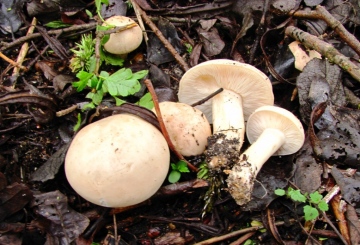
It is always a pleasure to see young life appearing at this time of year, albeit if it was the broods of three and six Canada and eight Egyptian Goose goslings present at Handley Barns on 6th. They have an appealing innocence when first hatched, even if they all too soon grow into raucously honking adults! Alas, young Coot lack the 'cute factor' even at this age, and the adults are appalling, but at least the three young that appeared at Blue House (the first of the season) on 8th bore testimony to the success of their parents strategy of frantic nest enhancement during the recent floods. More to my taste were the brood of nine Mallard ducklings there on 10th, only the second such seen this year, the high water levels having seemingly inhibited the females from nesting earlier.
Damp spring weather is more beneficial to annual plants that the dry ones of late but they need a bit of warmth to go with it and the lack, so far, has inhibited them. The flora that thrives on the dry tops of the counter walls at Blue House - and which is different from anywhere else on the farm - is usually at its peak in May but there is little to be seen this season apart from some late flowering Early Whitlow Grass, masses of Sticky Mouse-ear and a few patches of its scarcer cousins, Sea and Little Mouse-ears. A large patch of White Comfrey on a roadside verge was a new record for my home parish on 11th but a visit to nearby Fryerning Churchyard coincided with the arrival of the gardening contractors and I had to watch as the buds of buttercups, dog daisies, vetches, clovers, trefoils, medicks, cranesbills and much else besides - all about to burst forth into glorious technicolor - were shredded asunder into a billiard table-like dreariness. Sigh! During my cycling days I used to love visiting parish churches. Nearly all were open to the public in those days and each one seemed to have a different feel to it. Nearly all the churchyards were blighted though by the curse of the contractor's mower. At High Rodingbury one year they mowed around 200 Bee Orchids! Sometimes, in exasperation, I pinned a little ditty to the notice board in the porch, to wit,
- All Things Bright and Beautiful,
- All Creatures Great and Small,
- All Things Wise and Wonderful,
- The Sexton Mowed Them All!
I always added my name and address but no-one ever got back to me.
Finally, to a Moth Night at Linders Field, Buckhurst Hill on the evening of 11th, organised by Epping Country Care, at which I assisted along with fellow club members Anthony Harbott and Martin McCleery. It was a cold night - a very cold night - and we only caught four species - Green Carpet, Angleshades, Brindled Pug and White-shouldered House Moth - but the fifteen or so people that turned up seemed to thoroughly enjoy themselves, most remaining until the event closed around midnight, and their enjoyment made for a very rewarding evening all round. On returning to Ingatestone the next day there were also four species in my garden trap - a Brimstone, Shuttle-shaped Dart, Muslin and the Spectacle illustrated below; unbelievably, the best showing since the warm weather at the end of March but a sign that events may at last be on the up.
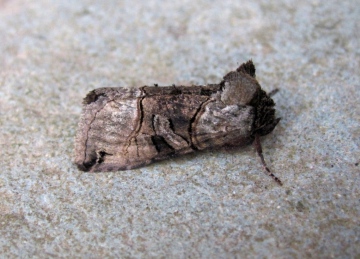
Elders again
As there still appears to be comments regarding Elders, thought this might just add some very
antiquarian data on the topic. I had a look in my wonderful old and 'wikipedia' like English Cyclopaedia
of 1855. These wonderful volumes, fantastically detailed, sorry about the superlatives, but they truly
are incredible. I have all four on Natural History and each is lavishly detailed and illustrated with beautiful
engravings. We bought eleven volumes for 10p each, these also covering Geography and Biography,
from a junk shop at the Bakers Arms, Walthamstow. Those were the days for book collecting way back
in sixties!
As usual I digress, so back to Elders. Here is what the writer had to say so long ago:
'Considerable medicinal value has at all times been popularly attributed to this plant, and it is only
recently that it has fallen into comparative disuse amongst medicinal practitioners. In the rural districts
of England a wine is made from the berries, which is in great repute, and when drunk hot is an agreeable
stimulant. The flowers are employed for making distilled water, which is frequently used as a refrigerant,
and on account of its agreeable odour is introduced into many articles of confectionery. The pith on
account of its solidity and great lightness, is used for making small figures and balls for electrical exper-
iments. The undeveloped buds, when pickled, form a good substitute for capers.'
Surely all a reflection of the wide degree of philosophical understanding of all things over one hundred and fifty years ago, a time when this country was in its prime - don't look around today! Sorry, Graham
Graham, I owe you an apology for being so dismissive. I think I have worked out what your pink blobs were, mostly from the further information you sent that followed the first finding. I think it is probably a Myxomycete (aka Slime Mould) called Lycogala epidendrum (no common name, as far as I am aware). It is extremely common, especially in spring, with its spherical pink blobs about 1cm across on dead wood. They 'ripen' in a few days to what is effectively a pale brown blob of dusty spores. So I don't need to see your preserved sample of this one. Please don't bother with saving it to show me later, as many are allergic to its huge release of spores, including me!
But your alarming orange thing I really have no clue about, but it does not look like another Myxo. By all means bring me some of that, dried. But please also make notes of what it looks like and feels like and its dimensions when fresh, as so many soft fungi or relatives seem quite different when dry. And I certainly cannot guarantee to name it at all, let alone correctly. Sorry Mary!
Mary - having accompanied you on many a foray I have developed a healthy respect for your knowledge of 'little brown jobs' but this one, I admit, was going a bit far! Trouble is, I am a mycological coward and am apt to view certain groups as beyond my ken rather than as a challenge. Anyway, the following is a close up of the same fungi taken two days later, the pink blobs having matured to a less showy grey-brown. Each fruit body is up to 7mm across and as you can see are often fused together. They have not only changed colour but have gradually hardened to the touch and are now rubbery rather than soft with an olive grey spore mass. A Hypoxylon possibly? Or even a Myxomycetes? Anyway, I have now dried some specimens and will bring them along to the first of the Club's autumn forays. It is bound to be bone dry by then and we will need something to look at!
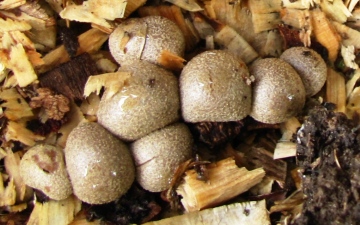
It is with a certain degree of trepidation that I offer another picture for you to look at - a slime mould possibly. It was growing from the root plate of a long dead and toppled Sweet Chestnut stool at Stoneymore Wood, Mill Green this week. It was quite large - around 4-5 cm across - and shaped like a shallow bowl. Impossible to collect, of course, without a proper container as it was slimy and fragile.
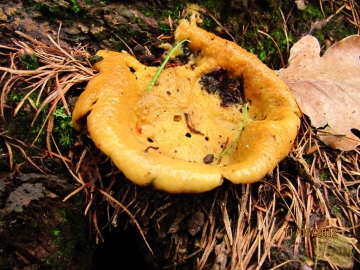
Finally, to one I was brave enough to tackle. It was growing on the same wood chip/sawdust mix as the pink blobs and played out in Brian Spooner's updated key on CABI as Peziza varia, which appears to be common on this kind of substrate, the map showing lots of records from the London/Essex area. Have kept a specimen of this as well, which I hope will be one of the first fungi to deposited at our new HQ as soon as the collections are up and running.
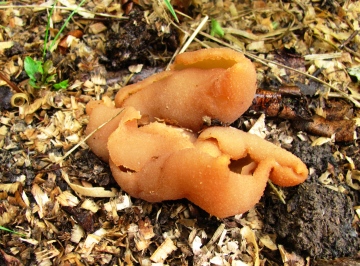
Wild Strawberry and Pink Blobs
Peter, your identification is indeed of Wild Strawberry. I hope it is on calcareous soil, as Wild Strawberry only flourishes there. Do go back in July and eat same! Although the strawberries are tiny, their taste is wonderful!
Graham, re your pink fungus thing. I am sorry but I am not a magician or a Psychic! A photo does not enable me to distiguish an Ascomycete from a Basidiomycete from a Myxomycete! And with no scaling factor, the choice is rather large. Next time, please send me a bit! One very common one with pink blobs is Nectria cinnabarina, and this looks rather like the bright pink conidial stage. But, this depends on the size of the blobs, their texture, their structure inside etc. I cannot guarantee id in any case, but scale, internal structure etc are really vital! Wild Strawberry (Fragaria vesca)
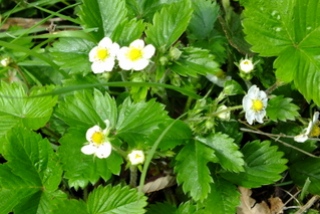
The above photograph was taken on 1st May at Wrabness Nature Reserve. It was during one of those very rare events these days, a warm sunny afternoon, and my wife and I decided to take some exercise. This was one of many clumps of these flowers which I believe are wild strawberries, found along the footpaths under the hedgerows. At least I believe this is what it was although I haven't come across it previously. Incidently while at the reserve we heard our first Cuckoos, 3 at seperate locations and a fourth actually seen. However the best of the afternoon was while we were in the hide when we were suddenly treated to the song of a nightingale which had perch on the inside of the hide with us, The back of the hide is open to the elements. It then flew into the lower branches of a nearby tree in full view of us to contnue its song. On returning home I checked the BTO website, and their cuckoo survey, noted by Graham earlier, and found that his 'Chris' was in Epping. So about that time the Cuckoos must have all decided the time was right for them to migrate. We thought this was absolutely fascinating. One for Mary
Mary, Any idea what these may be - an Ascomycetes perhaps? They were found by the assistant warden Tim Lawrence on chestnut/oak wood chips at Blue House Farm yesterday. I'm sure you will tell me that they could be one of around two dozen species! Perhaps we need to get Martin on the case. Glad to hear he is better by the way. Tim also found some interesting cup fungi, Peziza, also on wood chips. Are you any good on these as I find them very difficult even with the use of the keys in Field Mycology? He is going to collect some for me.
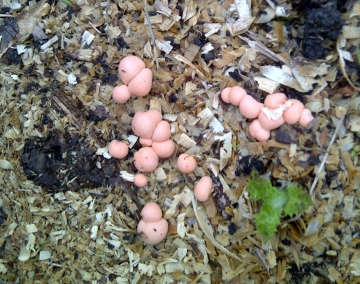
Thanks also for your comments on Elder and such like. I hope we haven't put Peter off his Elderflower Champagne! As for my garden, the early potatoes are going well apart from a little yellowing in places, which may be a sign of water-logging. If we were now to get some warm and humid weather they will probably get the blight! Had a good crop last year, though, as they lasted me for over three months. As for the young Purple Sprouting - I have now abandoned them to the slugs and will have to buy some more. I refuse to use the blue pellets and they have overwhelmed my beer traps. Perhaps I should try Elderflower Champagne in them instead........... With a philosophy of "there is no such thing as a weed, only a misunderstood wild flower" I'll always be a hopeless gardener though!
PS : I have identified the culprit! It is the Common Garden Slug Arion distinctus. Or it could be its close relative Arion hortensis. They need an operation in order to distinguish them and although I'm tempted I'm not really into that. Perhaps I ought to have a Plan B; hollowed out orange halves scattered among the Purple Sprouting plants, any slugs attracted then being deposited in a neighbour's garden! Replies to some questions of recent days
I am sorry that I wrote all this stuff about my garden before reading all the other comments of interest in the past week or so.
Alexanders: re Graham's comment, I can really only say: don't count your chickens! In two or three years time you will probably be yanking the stuff up all over Ingatestone!
And yes, I have noticed very few insects on it. I think, but may be wrong, that many alien plants in UK have very few insects on them because the natural insects do not accompany the plants in the transfer. For example: Sycamore trees support very few invertebrates, or fungi, in UK, though in their homelands they have lots. And conversely, Oaks have more livestock associated with them than any other tree in UK, and they also have loads of fungi associated with them. Bee Orchids, although native here, have a real home in the
Mediterranean region. In UK no Bee Orchids are pollinated by insects, as the particular bees do not live here, or are very rare. So Bee Orchids in UK always self-pollinate, which is one reason why there are so many abnormalities of Bee Orchids in Britain. Further examples abound!
Elder and its poisons: I have never come across this! And the 'explanation' about a glycoside releasing cyanide in human metabolism sounds very unlikely. However, my husband, who is a biochemist, has searched his books and has confirmed that a number of plants, particularly their seeds, such as almonds, do contain substances that transform this way in the human body, when they are in contact with certain enzymes. His book does not mention Elder specifically, but it is apparently a fairly widespread phenomenon. In particular, if an almond tastes bitter, spit it out!
Night skies: What a lovely account of how to explore the heavens at home! Light pollution is a major problem where I live in Upminster, in Greater London. However, we have driven through the Judean desert at night and been totally bowled over by a magnificent sky. And when we go camping in Scotland, miles from anywhere, we can admire the night sky, if the rain stops and clouds clear. And we have a friend in Zimbabwe, who we have visited a few times, who used to live near a poor village with no lights and no nearby town, where getting out for a leak in the night was an exciting adventure for us! (Outdoor loo!) But the stars were all different in the southern hemisphere. I agree totally with the writer who describes the effect on us of making us feel very tiny and insignificant looking up into the immense star-studded firmament! It is very good for us to feel so small sometimes. an afternoon in my garden
After lunch today, when we decided the sky was not likely to precipitate any more rain for a while, and the temperature rose above 8°C, I put on wellies to clear and dig the patch for the young tomato plants to go into. This patch had potatoes in last year, and I found enough potatoes to have fed us for another 4 meals in what I had failed to dig up last summer. Moreover, lots of the young plants had tiny new potatoes on them, which I threw into the weeding bin, but by the time I had finished we could have had another meal off them too! What a waste!
And, of course, a Robin soon came to see what I was doing and to see if he/she could catch some wriggly things from my turned-up soil. It seems that Robins know that humans like them, as they seem very brave in how close they come. But when I threw a handful of weeds into the bin, she/he jumped on to the fence and did not return to the soil till he/she thought it was safe. By the way, how do you sex Robins?
The warm moist soil was absolutely heaving with assorted small livestock. After each search the Robin flew to 3 gardens away where presumably there was a nest of youngsters. We continued our respective tasks for nearly two hours, with me enjoying his/her company as much as he/she clearly enjoyed mine (well, it seemed like that). And all this in glorious sunshine, on a warm afternoon.
After a short tea break, my husband joined me in the garden and he got the mower out to cut the lawn. Now, you have to understand that we mowed the lawn very late in March, when it felt like July. Then we had hail storms and I thought the potatoes would all freeze to death and much of the lawn was flattened. Luckily the potatoes came up anyway. But the rain never stopped, so mowing the lawn again had to wait until it was dry enough to mow without the mower chewing it all up. The day was today!
However, I was getting eaten alive by this time (about 6:30pm) by assorted airborne insects. I thought this was a bit off, on the first day the sun dries up the garden a bit we can't work without being attacked! In August and September I expect to be eaten in the early evening, but not in early May.
Then an hour or so later my husband was just cleaning up the mower, having completed his task, and suddenly the heavens opened with more rain. All electric cables etc were hurriedly put away and we dashed indoors.
How different this is from last year. Last year I planted the potatoes in mid March as usual, and they all needed a good soaking before the end of April, as we had had no rain for about 6 weeks, and watered again in May. But this year I am just hoping they are not all going to die of rot or blight or both.
But recent weather has been like many parts of England outside the South-east endure for much of the time. I have a sister who lives in Northumberland, which has gorgeous scenery, but she has to do gardening in the rain as you never get any done if you wait for a dry day. My brother who lives in Shrewsbury has exactly the same problem, only worse. So I am quite grateful for the weather we usually get in South Essex, but just hope someone will soon turn off the tap! May Moths.
Moth trapping continues to be poor with very few Moths being recorded in the trap but a few Micros are appearing in the Hedgerows and Woodlands around my part of North Essex, Adela reaumurella are showing in good numbers when the sun shines along with Incurvaria masculella, the odd Esperia sulphurella and Nematopogon swammerdamella are turning up to, Coleophora larval cases are worth searching for now.
A walk around Tiptree Heath produced lots of Cydia ulicetana and a couple Neofaculta ericetella.
My best find of the week has to be Prays oleae larva which i found in a Garden Centre in Braintree, i have been looking for these for a couple of weeks without success until today, I will post a few pictures of the Adult if i manage to rear a few through.
Steve Rolls. Elder Insecticide
Peter - I have consulted that great oracle of our age, Wikkipedia.com, and it informs me that, quote, 'The leaves, twigs, branches, seeds and roots contain a cyanide inducing glycoside (a glycoside being something which gives rise to cyanide as the metabolism processes it). Ingestion can cause a toxic build up of cyanide in the body'! It goes on to state that 'herbal teas made from an infusion of leaves should be treated with great caution as it can also cause a build up of cyanide'. Maybe that's where I got my notion of an insecticide from but it has nothing to say on that matter. The flowers and the berries seem to be okay although I do remember being warned not to eat too many of the latter as a child, probably becasue they were considered a laxative! Anyway, I hope the flowers and berries are okay as I am very fond of the odd glass of cordial myself!
Sadly, Wikkipedia also advises that kids should be discouraged from making whistles or peashooters from the stems for the reasons mentioned. Bit late for me I'm afraid. If that is true then I should have died from cyanide poisoning at an early age! Old wives tale I hope
Oh dear Graham, I read your latest forum entry with dismay,
Over the years we must have consumed many glasses of "insecticide" as a delicious, effervescent, drink we call Elderflower Champagne, perhaps not a p.c. title these days.
Sugar disolved in water with lemon slices, infused with a few elder flowers, has made us a drink to sit and sip while in the garden on hot summer evenings (whatever happened to those).
As for not being many insects on the flowers, no matter what we do to remove them, the infusion always seems to contain pollen beetles which have to be carefully strained out.
I do hope the insecticide view is an old wives tale. April 22nd-28th 2012
The stars. I don't notice them so much here at Ingatestone anymore. When I was working and had to get up at four-fifteen in the morning it was a different matter! On cold frosty mornings in winter there seemed to be as many stars as there had ever been and on more than one occasion I had a close encounter with a lamp-post when staring skywards while cycling to work! Once retired I vowed never to rise so early again. Four-fifteen was wits shattering, six-thirty is bliss! Also, even here at Ingatestone light pollution has increased significantly in the past three decades as neighbouring towns such as Chelmsford and Brentwood have expanded in size and as a result your eyes are no longer drawn automatically towards the heavens when stepping out in the morning. Only at Bradwell St Peter's, among my regular haunts, do the stars shine as brightly as they used to. Apart from a faint neon glow over Southend and a slightly brighter one above Mersea the darkness is still all pervading. Many a time I have spent the evening outside the Bird Observatory gazing at Saturn, Venus, Jupiter and the Moon through the telescope. At other times it was a pleasure just to sit on the edge of saltings, coffee cup to hand, and become immersed in the sky above. There is nothing like studying the stars for instilling a sense of humility. By the way, Mike, I have heard about your fossil bird collection from Barry Hough, who is often enthusing about it.
Mary - Alexanders does not seem to have spread along the A12 to Ingatestone as yet, my only records being a single plant in a local car park, the seeds having no doubt arrived glued to a car tyre, and also a roadside verge at nearby Highwood. It also occurs at Pleshey Mount or Castle and there is a suggestion that it was first introduced here as a vegetable by Augustinian monks in the middle ages. Did try chewing on a leaf once but quickly decided that Augustinian monks had a stronger palate that mine! Have you noticed, also, that although the blooms are prolific they seem to attract very few insects? The same is true of Elder blossom but someone once told me that the flowers contain a natural insecticide and were once used as such by immersing them in water overnight. An old wives tale?
Weather-wise it was another grim week; cold and wet on Monday, Tuesday, Wednesday, Thursday and Saturday! It has been a disastrous week for breeding birds at Blue House, the Lapwings suffering particularly badly. The young were due to hatch from the earliest laid clutches but they all seem to have died almost as soon as they emerged from the egg. The weather during their first week of life is crucial for young wader chicks as they need to feed themselves within an hour or two of hatching and keep reasonably warm and dry until their strength increases. Their parents can shelter them from the occasional heavy shower but they cannot survive the repeated torrential downpours we experienced this week, while the cold weather means that there are few invertebrates on which to feed. There is now more standing water on the reserve than at any time during the past two years and most of the ditches - where water levels were way below normal three weeks ago - are overflowing, resulting in the loss of several Dabchick nests; probably others species such as Mallard, Moorhen and Meadow Pipit as well. Coot are more adaptable. As water levels rise they frantically add sticks to their nests but when they subside again the incubating bird often finds itself perched on a two foot high pile of vegetation that makes them very obvious to potential predators and they have just as hastily to dismantle them again!.
What's bad for birds is, however, good for fungi and a number of species have appeared in the fields at Blue House this week including Fairy Ring Champignon Marasmius oreades, Yellow Fieldcap Bolbitius titubans, and both Egghead Panaeolus semiovatus and Bell-shaped Mottlegills P. papillonaceus var. parvisporus (top photo). The best find though was the Shield Pinkgill Entoloma clypeatum, (bottom photo)a spring species normally associated with the genus Rosaceae. In this instance they were growing in a pasture around ten yards from a hedgerow Dogrose so only just qualify!
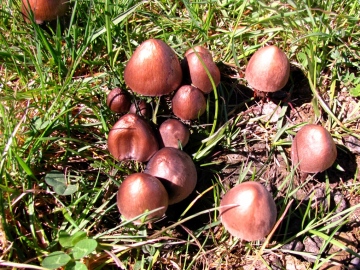
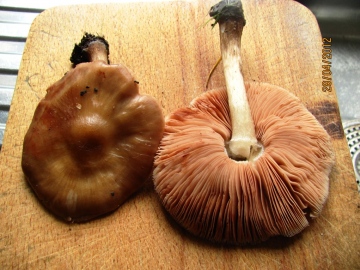
For the rest, spring had little to offer. Like Mary commented, many early flowering Bluebells seem to have died back during the cold weather and the displays to be found round here are a bit below par. Wood Anemones though are having a glorious spring. My garden moth trap yielded a Muslin, Lunar Marbled Brown and Brindled Pug on 22nd, the first new species for the year since 1st April, a month that usually sees around thirty species emerging for the first time. Finally, on 24th, over a hundred Swifts came in off the sea at Blue House after the rain stopped and headed west along the River Crouch, their appearance a sure sign of the lateness of the season. Some astronomy, some meanderings
Having commented on the need to for folk to contribute to the Members Forum, rather than
just read the thoughts of a select few who make the effort, I feel I should practise what I
preach. But what can I write that may prove of some interest, difficult given the likes of Graham
et al, who are hard acts to follow.
Maybe someone would like to hear of my recent project to install an astronomical observatory
on our balcony here in Holland-on-Sea. Really my great life's interest is prehistory - fossils and
because the Naze is only six miles from our home, this place has produced wonderful results
for me and my fossil bird collection from the London Clay of Walton is unquestionably second
to none and in that respect - I mean internationally! But that is quite a specialist subject and
think observing the heavens might be a topic of more general public appeal. After all just go
outside after sunset and look up and as long as the sky is clear of cloud (!!!), you may see,
despite all the light pollution especially if you live in town, the wonderful starry expanse of the
night sky. No need for any optical assistance and this particularly applies when there is a
chance of seeing meteors. These interesting, but tiny fragments of some extinct comet can
provide a remarkable display when a bunch of them burn up brightly when they enter the earth's
atmosphere. Could be, if you are lucky, a worthy diary entry. For those that might think a little
shooting-star watching could be a worthwhile distraction, I will try and post the dates when
there is a chance of seeing a meteor shower as these occur at more or less regular intervals
throughout the year.
Now about my more determined endeavours in the cause of amateur astronomy. To mark my
eightieth birthday, my cousins gifted me an very fine China made astronomical telescope. My
Australian cousin asked me if I would like a lap-top, fair enough, but I had this device and also
a desk-top, so I suggested the telescope and that is what I received, and a very impressive
instrument it is. Its arrival immediately brought me suddenly into a virtual new interest with quite
a lot to learn. I always had a fascination for looking up at the heavens and remembering my
young days during WW2, there was plenty to watch up above, aerial dog fights during the Battle
of Britain and because of the blackout restrictions, there was some wonderful dark nights when
the the moon and the stars shone down in all their glory.
The question thus arose, where to site this impressive instrument. Our garden is short and
although quite wide is bordered by a high privet hedge that belongs to the adjacent care home.
Although obscuring much of the lower south-eastern sky, it provides an important refuge and
nesting place for our Blackbirds, Dunnocks etc, but also for a colony of House Sparrows which
must reach, at times, around sixty in number. There are surely other more obscure avian inhab-
itants in this thick cover; once our cat brought in a dead, but hardly damaged Garden Warbler,
that finished up in my comparative skeletal collection to assist with identifying Naze fossil birds.
It was this specimen particularly, that had features in its anatomy that lead to a belief that very
primitive forms of the Passerines - song birds - were present in the Lower Eocene period, circa
fifty-four million years ago.
After these digressions I'll try to return the telescope installation. It is essential that this instru-
ment has a very firm base as due to its magnification power, it must have rock-solid stability to
avoid vibration when viewing far distant objects. One day when accompanying a builder friend
to B & Q buying materials, I wandered off to the sheds section. More or less the first display
item was a kiddies play hut and at a ridiculous price reduction deal. Thinking quickly, an excep-
tion that day perhaps, rather than my normal more ponderous reaction, I thought play hut +
balcony and given certain modifications to increase length and height, the unit could be sited
over our existing access hatch accessible by a flight of stairs from our second bedroom. So I
placed an order for this small, but well designed wooden cabin. Eventually after several weeks
delay I received a call that my flat-packed shed was in store awaiting collection. My friend with
his trailer was engaged to pick up the hut and we deposited it in our conservatory. Here, the
sections and fittings were unpacked and fairly quickly I had the little building temporarily assem-
bled along with a plinth added to increase head height for adult occupation rather that for kiddie
use. Also I had to redesign the roof so that panels mounted on hinges, would open to reveal the
sky in true observatory fashion. Next stage, with the hut reduced to its dissembled components,
these to be lifted on to the balcony and then speedily, once more bolted and screwed together
in their final position on the roof.
It was soon confirmed that the little place had fully lived up to expectations indeed providing in
daytime good all round views of both sea and land. And after dark when the weather here deci-
des, well at least occasionally, to allow clear views of that magnificent free spectacle, the night
sky.
From this vantage point it is also interesting to see into neighbouring gardens, oh yes I visited
several local residents to assure them that this new addition on our balcony was not installed so
I could pry on them from above and all seemed happy with my explanation. Now instead of our
previous restricted views we can see what is happening both near and far. Immediately bordering
our property we can see into the garden of the nearby villa that was originally the summer seaside
residence of the Countess of Warwick and it was she that acquired quite a reputation in late
Victorian and into Edwardian times for her associations with the then Prince of Wales, he later
to become Edward V11. Also of perhaps of some interest to Essex Field Club members, she
was a great friend of Professor Raphael Meldola one of the orginal founders of the society. She
also was herself a great animal lover and if one still has an early edition of Warne's The Observer's
Book of British Birds, you may find that the work contains her forward. Our place here was the
chauffeur's house.
Due to the continuing inclement weather, have had little opportunity to do much sky-watching,
but have been greatly compensated by having a cosy place to watch the sea in all its moods.
The recent storms churning the waters and also giving us a good view of the Gunfleet Sands wind-
farm. Maybe I am not alone in having distinctly critical views of these so called clean energy providers.
No argument, being able to watch the day to day performance of these off-shore turbines has done
little to help change my view that these units are obtrusive, and of marginal green benefit, except
that is, to all those have acquired some very lucrative contracts! Installed at vast outlay, expensive
to service - quite sizeable vessels in regular attendence, further, given the vagaries of our climate,
the evidence must weigh heavily that they are both inefficient and poorly cost affective. We can
see the days when in near calm conditions their sails hardy revolve at all and at other times, when,
for some unknown reason, a number are out of commission. Nevertheless, the powers that be
already have plans to add another eighteen even taller units.
One more aside prompted by roof top observations. Now we have a wide view of the land here-
abouts, can better take in the local bird population. Unfortunately, nothing very special to report,
but thinking about the time twenty-seven years ago when we moved here, regretably the avi-fauna
is now clearly much reduced. Then we had Redpolls, both Mistle and Song Thrushes, lots of Green
finches, House Martins, Starlings were common, we often saw Kestrels and a Tawny Owl was
disposed to sit on our gutter. Had the occasional Great-Spot and once even had a
wonderful opportunity to photograph a Lesser-Spot on our roadside tree. Now, sure plenty of
Collared Doves, Woodies and one small bird we do have in quantity are those House Sparrows.
Also have a family of Jackdaws and many noisy Herring Gulls who freely nest on nearby proper-
ties, but on the minus side, Blue and Great Tits are now in short supply and Wrens a rareity. Of
the others earlier mentioned, most have long disappeared. However, there is one male Chaffinch
whose repetitive, rather boring call, has been regularly with us for several years now - will he ever
find a mate?
I do hope some parts of this multi-topic deliberation, has created at least a modicum of interest.
Alexanders
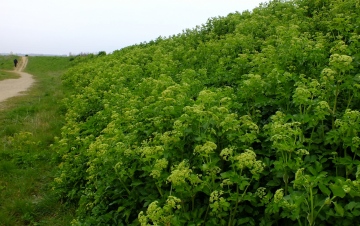
Thanks for the comments Mary
This photograph is of Skinners Wall, Manningtree, taken on 3rd April, just to illustrate the extent of the advances the plant is making here. Not so long ago there were a few plants, now everything else swamped out. Alexanders is taking over
Yes, you are correct.
It is on many roadsides, helped by salt in winter, along with a variety of other, smaller, coastal plants that have been spreading on roads all over Britain.
Also, Alexanders was introduced to Britain by the Romans, for use as a vegetable. So it is at home in a Mediterranean climate. So global warming in Britain is surely encouraging its spread.
Another factor must be is that it grows so fast in spring that it crowds out other plants which cannot compete at that time of year.
Another factor is that rabbits don't like its taste. Neither do cattle, horses, or sheep. So it has nothing much that eats it up. A very few tiny fungi eat it, but they cannot multiply fast enough to slow its growth. Alexanders
On the subject of Alexanders, is it just me or is this plant spreading. It seems to be more abundant than in the past and I have noted it away from the coast. It is in verges at Ardleigh among other inland sites. Skinners Wall, Manningtree has been taken over in parts by this plant. |
|
Archives:
May 2020
Aug 2019
Jan 2019
Sep 2018
Jul 2016
Oct 2015
Jul 2015
May 2015
Apr 2015
Mar 2015
Feb 2015
Jan 2015
Dec 2014
Oct 2014
Sep 2014
Aug 2014
Jul 2014
May 2014
Apr 2014
Mar 2014
Feb 2014
Jan 2014
Dec 2013
Nov 2013
Sep 2013
Aug 2013
Jul 2013
Jun 2013
May 2013
Apr 2013
Mar 2013
Feb 2013
Jan 2013
Dec 2012
Nov 2012
Oct 2012
Sep 2012
Aug 2012
Jul 2012
Jun 2012
May 2012
Apr 2012
Mar 2012
Feb 2012
Jan 2012
Dec 2011
Nov 2011
Oct 2011
Sep 2011
Aug 2011
Jul 2011
Jun 2011
May 2011
Apr 2011
Mar 2011
Feb 2011
Jan 2011
Dec 2010
Nov 2010
Oct 2010
Sep 2010
Aug 2010
Jul 2010
Jun 2010
May 2010
Apr 2010
Mar 2010
Feb 2010
Nov 2009
Oct 2009
Aug 2009
Jul 2009
Jun 2009
May 2009
Apr 2009
Mar 2009
Feb 2009
Jan 2009
Nov 2008
Oct 2008
Sep 2008
Aug 2008
Jul 2008
Jun 2008
May 2008
Apr 2008
Mar 2008
Feb 2008
Jan 2008
Dec 2007
Nov 2007
current posts
|







































